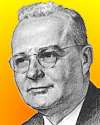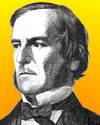
Thomas Midgley Jr. (1889-1944) was an American engineer and chemist who discovered the effectiveness of tetraethyl lead (C2H5)4Pb in 1921 as an antiknock additive for gasoline (petrol). At the time it seemed like a wonderful invention, to run engines more smoothly with less damage. Years later, the hazard of lead released into the atmosphere was realized, and the sale od leaded gasoline ended. He also developed carbon tetrafluoride as a cleaning agent, and the chlorofluorocarbon compound later called “Freon” for refrigeration. These too have been shown to have hazards, including damaging the Earth's ozone layer. To read about the enthusiasm surrounding these compounds when first introduced, read the 1940s radio talk by Charles Kettering praising his colleague, Thomas Midgley. Even if his pet projects later were reversed with greater understanding of their chemical effects, Midgley's dedication as a researcher remains interesting reading.

On 2 Nov 1944, Thomas Midgley died, whose contributions to the chemistry of his era included leaded gasoline and freon. These, his two most infamous inventions, are now known to produce immense environmental damage. Freon replaced toxic refrigerants, but is now a banned CFC because it destroys atmospheric ozone. The tetra ethyl lead additive was a boon to prevent damaging "pinging" in car and airplane engines, but contains distributes lead, a toxic heavy metal that accumulates in plantlife and the body. Yet he deserves to be remembered for his hard work, creative genius, and a passion for research. Today's book pick is: From the Periodic Table to Production: The Life of Thomas Midgley, Jr., the Inventor of Ethyl Gasoline and Freon Refrigerants, by Thomas Midgley, his grandson, who provides more than a biography. A large portion of this book provides much useful material, including patents, awards, texts of Midgley's speeches given on various occasions, and examples of his poems.
It is available from Amazon, typically about New from $23.25. Used from $20.71. (As of earlier time of writing - subject to change.)
 | The most satisfactory definition of man from the scientific point of view is probably Man the Tool-maker. |
 | If a problem is clearly stated, it has no further interest to the physicist. |
 | The beauty of physics lies in the extent which seemingly complex and unrelated phenomena can be explained and correlated through a high level of abstraction by a set of laws which are amazing in their simplicity. |
| Before you look at today's web page, see if you can answer some of these questions about the events that happened on this day. Some of the names are very familiar. Others will likely stump you. Tickle your curiosity with these questions, then check your answers on today's web page. | |
| Births | |
 | An English mathematician, born 2 Nov 1815, helped establish modern symbolic logic. Now named after him, his algebra of logic, is basic to the design of digital computer circuits. Can you name this man? |
| Deaths | |
 | Kenneth Oakley (1911-1981) was an English physical anthropologist, geologist, and paleontologist best known for his work in the relative dating of fossils by fluorine content. While working for the British Natural History Museum, Oakley become famous in 1953 for exposing a forgery. A skull had been “unearthed” in 1912, in England, and had for decades been said to represent the “missing link” in human evolution. He proved it was nothing more than a modern human braincase and an orangutan jawbone. By what name is the forged "missing link" human ancestor known? |
| Events | |
 | On 2 Nov of a certain year, the DuPont company, of Wilmington, Delaware, announced the first synthetic rubber this day. It was known as DuPrene. In what decade was this product announced? |
 | On 2 Nov 1947, Howard Hughes piloted his huge wooden airplane on its only flight, which lasted about a minute over Long Beach Harbor in California. It was the first test of a U.S. plane with eight engines. Wing span was 319 feet, 11 inches. Can you name this airplane? |
Fast answers for the previous newsletter for November 1: Steady-State theory of the universe • Pangea • Pampers disposable diapers • Marianas Trench in the western Pacific Ocean • decade containing the year 1952 • Goodyear.
 If you enjoy this newsletter, the website, or wish to offer encouragement or ideas, please send feedback by using your mail reader Reply button.
If you enjoy this newsletter, the website, or wish to offer encouragement or ideas, please send feedback by using your mail reader Reply button. Your click on a Facebook, StumbleUpon, or other social button on the site webpages is also a welcome sign of appreciation. Thank you for using them.
© This newsletter is copyright 2020 by todayinsci.com. Please respect the Webmaster's wishes and do not put copies online of the Newsletter — or any Today in Science History webpage. (If you already have done so, please remove them. Thank you.) Offline use in education is encouraged such as a printout on a bulletin board, or projected for classroom viewing. Online, descriptive links to our pages are welcomed, as these will provide a reader with the most recent revisions, additions and/or corrections of a webpage. For any other copyright questions, please contact the Webmaster by using your mail reader Reply button.
--
If you do not want to receive any more newsletters, Unsubscribe
To update your preferences and to unsubscribe visit this link
Executive Real Estate Business Class
-
"It was like a man with wings. It wasn't like anything you'd see on TV or in a monster movie." ...
About the publisher
Search This Blog
Blog Archive
-
▼
2020
(1542)
-
▼
November
(164)
- Last day to save! Take advantage of Black Friday d...
- On This Day for November 30 - Independence of Barb...
- Newsletter for Monday 30 November.
- November 30: Cnut the Great, the 1st State to Abol...
- FAMILY: Happiness in a stressful season
- Medieval monarchs | WW1 quiz | Marlborough pie recipe
- On This Day for November 29 - United Nations resol...
- Newsletter for Sunday 29 November.
- November 29: Edison's Phonograph, Schrödinger's Ca...
- The Compass: Italy
- See the past through a different lens with Nat Geo...
- On This Day for November 28 - Opening of Tehrān Co...
- Newsletter for Saturday 28 November.
- November 28: Exploration, Invention and a Day of F...
- PHOTOGRAPHY: How adversity inspired discovery for ...
- The gift of curiosity lasts a lifetime. Give Nat G...
- Very Weird — And Very Real — Facts About The Victo...
- Black Friday Deals: Save 50% on a Britannica Membe...
- Black Friday Savings at the HISTORY Store
- On This Day for November 27 - Nobel Prizes establi...
- Newsletter for Friday 27 November.
- November 27: The Model Parliament, the 1st Native ...
- ANIMALS: The pets I’m thankful for
- A Very Special Thanksgiving Edition Of Our Newsletter
- On This Day for November 26 - Premiere of Casablan...
- Newsletter for Thursday 26 November.
- YOUR WEEKLY ESCAPE: They live in a legendary under...
- November 26: 1st National Thanksgiving, Alice in W...
- SCIENCE: The prehistoric truth about turkeys
- UPDATED: Every Membership Now 50% Off!
- Every Membership Now 50% Off!
- Demystified: Is the Ozone Layer Finally Healing It...
- On This Day for November 25 - Japanese military ba...
- Newsletter for Wednesday 25 November.
- November 25: Dynamite and The Mousetrap
- TRAVEL: Keeping your family safe over the holidays
- Meet The Real-Life "Dexter" — Serial Killer Of Mur...
- On This Day for November 24 - Dutch discovery of T...
- Newsletter for Tuesday 24 November.
- November 24: 1st Transit of Venus Observed, Van Di...
- HISTORY: The faces of COVID-19’s toll
- New This Week on History News Network
- On This Day for November 23 - Ley Juárez passed, I...
- Newsletter for Monday 23 November.
- November 23: On This Day in History
- FAMILY: Keeping the holidays familiar for your kids
- The many faces of Anne Boleyn | Take our Tudors qu...
- On This Day for November 22 - U.S. President John ...
- Newsletter for Sunday 22 November.
- November 22: Vasco da Gama Rounds the Cape and JFK...
- The Compass: Hawaii
- On This Day for November 21 - Signing of Mayflower...
- Newsletter for Saturday 21 November.
- November 21: The Mayflower Compact, a Jewish state...
- CORONAVIRUS UPDATE: 200,000 new cases in a single day
- PHOTOGRAPHY: Switching tactics to chronicle the wo...
- How The Kennedy Curse Has Tormented America's Firs...
- On This Day for November 20 - Mexican Revolution l...
- The Roundup Top Ten for November 20, 2020
- Newsletter for Friday 20 November.
- November 20: Uyghurs Conquer China, the Napoleonic...
- ANIMALS: The deadly thing about snakes
- Give your kids a love of learning with Nat Geo Kid...
- #1 Gift for Families this Holiday - On Sale Now!
- On This Day for November 19 - Anwar Sadat's visit ...
- Newsletter for Thursday 19 November.
- November 19: "Four Score and Seven Years Ago..."
- YOUR WEEKLY ESCAPE: Not all of the dinosaurs died
- SCIENCE: Can we make North America’s greatest reso...
- The Latest News from History News Network
- On This Day for November 18 - Jonestown massacre, ...
- Newsletter for Wednesday 18 November.
- November 18: St. Peter's Basilica is Consecrated a...
- TRAVEL: Best of the World 2021
- Black Friday Early Access! 50% off Holiday Bundles...
- Photographer Captures the Impacts of Climate Chang...
- On This Day for November 17 - Arnold Schwarzenegge...
- Newsletter for Tuesday 17 November.
- November 17: On This Day in History
- HISTORY: Thanksgiving in tough times
- New This Week on History News Network
- On This Day for November 16 - Election of Bhutto a...
- Newsletter for Monday 16 November.
- November 16: Francisco Pizarro Ambushes Atahualpa,...
- FAMILY: Keeping kids kind during this stressful time
- The Crown S4 | Henry VIII's seventh wife | Vikings...
- On This Day for November 15 - Palestinian statehoo...
- Newsletter for Sunday 15 November.
- November 15: The Scramble for Africa and the Vietn...
- The Compass: Peru
- On This Day for November 14 - Eritrea made a provi...
- Newsletter for Saturday 14 November.
- CORONAVIRUS UPDATE: The U.S. enters uncharted terr...
- November 14: Kirch's Comet, Einstein's Theory of L...
- PHOTOGRAPHY: In the land of Arctic dreams
- The Unhinged Soldier Who Avenged Lincoln's Assassi...
- The Roundup Top Ten for November 13, 2020
- On This Day for November 13 - Terrorist attacks in...
- Newsletter for Friday 13 November.
- ANIMALS: Images to surprise and delight during thi...
-
▼
November
(164)
-
Blogroll
-
About
HistoryFact










0 comments:
Post a Comment